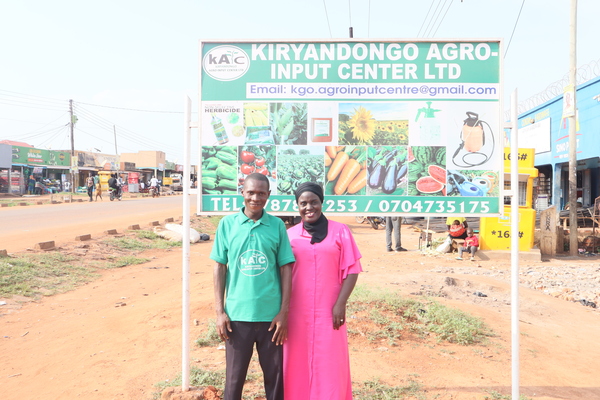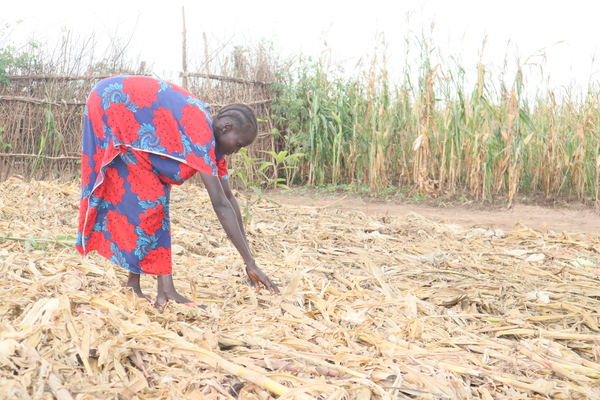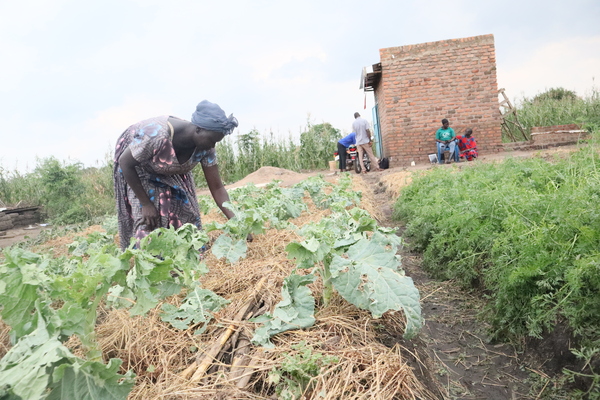By Omony Denis
Amidst the anxiety of displacement, erratic weather, and food insecurity, refugees in Kiryandongo settlement are turning to a climate-resilient farming technique called Pfumvudza to fight hunger and build resilience.
For families relying on dwindling food aid and limited land, growing their own food is not a luxury but a vital necessity for survival.
In November 2024, Kiryandongo Agro Input Center Limited, an agro input dealer in Kiryandongo district launched the use of Pfumvudza Model to promote optimal production of vegetables and other food crops on the available plots..
The notable crops mostly grown under the model are sukumawiki, carrots, onions, tomatoes, maize among others.
Since the introduction of this unique model, 860 refugees have been trained, and 12 Pfumvudza demonstration plots established.
The plots are usually small ranging from as little as 6 by 6 meters to a maximum of 39 by 16 meters.
Pfumvudza emphasizes soil conservation through mulching with grass, and the application of manure and fertilizer before planting seeds, which typically takes place one week after land preparation.
Joyce Medina Benjamin, a South Sudanese refugee, is one of the beneficiaries of the Pfumvudza model in the Kiryandongo refugee settlement.
“When we started using the model, we immediately began seeing the benefits, especially because it suits our small pieces of land,” she said.
Medina, who has only half an acre for both her home and garden, said the Pfumvudza model has made farming more practical and efficient.
As the leader of a group of farmers at the demonstration plot in Cluster L, she added that many community members have already embraced and appreciated the approach.
“I see farmers already overjoyed by the positive impact of the Pfumvudza model,” Medina said.
“When you plant using this method, you harvest more food and many beneficiaries are even selling part of their produce to meet other basic needs,” she added
According to the International Rescue Committee, the Global Acute Malnutrition (GAM) rate in Kiryandongo Refugee Settlement was estimated at 9.1 percent as of March 2024, just below the World Health Organization’s emergency threshold.
This high rate stems from compounding factors including disease, poor dietary intake, and inadequate child‑feeding practices
However, through the Pfumvudza model, Medina was able to save money she had previously spent on weeding, as the method significantly reduces weed growth.
“I have been using the extra money I save to provide nutritious food for my six children and also pay their school fees something that was very difficult in the past,” Medina recounts.
She now plans to adopt the Pfumvudza model across all her gardens in the next planting seasons.
“In every garden I open from next season onwards, I will embrace Pfumvudza because it gives higher yields compared to the traditional way of farming,” she noted
William Mabende is another refugee in the Kiryandongo settlement who has also benefited from the model.
William Mabende, who has lived in the Kiryandongo settlement since he was displaced by a landslide in Mbale district in 2010, has long struggled to provide enough food for his family which is now not that case.
He currently resides in Cluster D of the settlement. “What I have seen with this model is impressive, the crops stay green and the yield is much better,” said Mabende.
Mabende explained that he used to cultivate two acres of maize and harvest only ten bags, selling seven and keeping three for food.
“I am making a testament that with the Pfumvudza model, I now harvest up to 20 bags of maize from just half an acre. To me, that’s a huge plus,” he added.

Despite the tedious work of collecting mulch and preparing the Pfumvudza garden, Mabende remains satisfied with the model’s results.
“I used to spend at least UGX.120,000 on labor for weeding four times each season. Now, I only weed once, which has helped me save about UGX. 70,000. I use the savings to buy other vegetable seedlings and greens,” said Mabende.
Just like Madina and Mabende, Matha Nyakur Riek, is another refugee in Cluster L who also is benefitting from Pfumvudza Model.
Upon realizing the benefits of the Pfumvudza model, Riek left her original group and opened her own garden using the method.
“I used to farm the usual way in my 12 by 10 meters plot of land, but the constant frustration nearly made me give up. Sometimes, I couldn’t even harvest a basin of produce from my plot,” Riek shared while extending gratitude to Kiryandongo Agro Input Center Limited for the bailout.

Despite praising the project, refugees raised concerns about the tiring work involved in collecting mulch, with some walking as far as two kilometers to find grass. They also noted that the grass used for mulching often becomes a hideout for snakes.
Nalunkuma Halima, is the director of Kiryandongo Agro Input Center Limited.
She explained that the Pfumvudza model focuses on smallholder farmers most of whom were allocated between half an acre to one acre of land.
This also explains why the refugees were targeted rather than host community members who own large chunks of land some of which are not put to productive use.
“We have so far trained 860 refugees and established 12 demonstration farms in the refugee settlement,” she confirmed.
Halima explained that the model follows the principles of conservation agriculture, including careful planning, marking the size of the land to help farmers determine the number of seedlings needed, and estimating the expected harvest.
She further added that the model incorporates the use of fertilizers and manure, which has already resulted in improved yields among the beneficiaries.
“We have seen positive results for example, the half-acre plots are producing more from the same portion of land compared to the traditional model,” she said.
On the challenge of sourcing mulch, Halima advised farmers to use alternative available materials.
“We always implore them that maize stalks can be used as mulch instead of traveling over a kilometer to find grass, and that they should also store mulch for future use instead of destroying,” Halima said.
She expressed confidence that most farmers will adopt this model, especially since they have already started seeing immediate benefits.
“For instance, during a drought that lasted over three weeks this season, many crops were affected but Pfumvudza farmers were smiling because their crops remained healthy,” she added.
Halima urged more farmers to embrace the Pfumvudza model, and for those unable to adopt it fully, she encouraged them to embrace mulching practices to help mitigate the real effects of environmental changes.
Barnard Savion Bukenya is the agricultural extension worker in charge of Bweyale Town Council and Kiryandongo Refugee Settlement.
According to Bukenya, he had the opportunity to visit the demonstration farms, which emphasize zero tillage, a practice he says has significantly increased crops yields among the refugees.
“Just to remind you, these farmers practicing the Pfumvudza model didn’t even plant on time last season, yet the yield they realized from their demonstration farms was much higher compared to where the model was not practiced,” said Bukenya.
Similarly, Issa Hassan Byenkya, the district production officer for Kiryandongo, acknowledged that the Pfumvudza model is a driving force in addressing food insecurity within the settlement.
“It’s clear that the model works. Anyone who has applied it and seen its efficiency in producing better yields should be able to adopt it. It also addresses low income levels since farmers can sell surplus produce,” he said.
Byenkya believes the model has arrived at the right time to tackle the food crisis among refugees.
“The refugees currently face a major challenge as food aid has been drastically reduced by more than half following the US Trump policy. Seeing them grow food they can rely on for both cash and consumption is a huge relief,” according to Byenkya.
𝘛𝘩𝘪𝘴 𝘴𝘵𝘰𝘳𝘺 𝘸𝘢𝘴 𝘱𝘳𝘰𝘥𝘶𝘤𝘦𝘥 𝘸𝘪𝘵𝘩 𝘴𝘶𝘱𝘱𝘰𝘳𝘵 𝘧𝘳𝘰𝘮 𝘐𝘯𝘧𝘰𝘳𝘕𝘪𝘭𝘦 𝘪𝘯 𝘱𝘢𝘳𝘵𝘯𝘦𝘳𝘴𝘩𝘪𝘱 𝘸𝘪𝘵𝘩 𝘗𝘢𝘭𝘭𝘢𝘥𝘪𝘶𝘮 𝘶𝘯𝘥𝘦𝘳 𝘊𝘭𝘪𝘮𝘢𝘵𝘦 𝘚𝘮𝘢𝘳𝘵 𝘑𝘰𝘣𝘴


